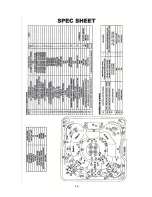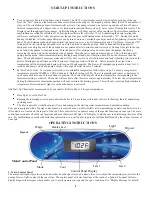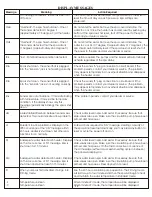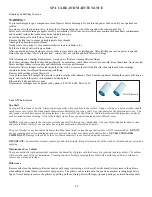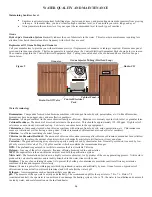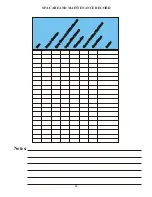
Balancing Total Alkalinity (TA)
!
The recommended Total Alkalinity (TA) for your spa water is 125-150 ppm.
!
Total Alkalinity is measure of the total levels of carbonates, bicarbonates, hydroxides, and other alkaline substances in
the water. TA is referred to as the water’s “pH buffer”. It’s a measure of the ability of the water to resist changes in pH
level.
!
If the TA is too low, the pH level will fluctuate widely from high to low. Fluctuations in pH can cause corrosion or
scaling of spa components. Low TA can be corrected by adding pH/Alkalinity UP (sodium hydrogen carbonate).
!
If the TA is too high, the pH level will tend to be high and may be difficult to bring down. It can be lowered by adding
pH/Alkalinity down (sodium bisulfate).
!
Once the TA is balanced, it normally remains stable, although the addition of more water with a high or low alkalinity
will raise or lower the TA reading of the water.
!
When the Total Alkalinity is within the recommended range, proceed.
Balancing Calcium Hardness (CH)
!
The recommended Calcium Hardness (CH) level for your spa is 150-200ppm.
!
Calcium Hardness is a measure of the total amount of dissolved calcium in the water. Calcium helps control the
corrosive nature of the spa’s water. That’s why calcium-low water (commonly know as “soft” water) is not
recommended. It is very corrosive to the equipment, and can cause staining of the spa shell. If the calcium level is too
low, we recommend using Calcium Increaser to bring the calcium hardness level to within the recommended range.
!
If the CH is too high (commonly know as “hard” water), formation of scale on the spa’s shell surface and equipment can
result. CH can be decreased by dilution - a mixture of 75% hard and 25% soft water will be a good starting point. If soft
water is not available, or practical for you, a stain and scale control such as Scale Defense should be added to the spa
water, according to instructions on its label.
!
Once the CH is balanced, it normally remains stable, although the addition of more water with a high or low calcium
content will raise or lower the CH reading of the water.
!
When the Calcium Hardness is within the recommended range, proceed.
Balancing The pH
!
The recommended pH level for your spa water is 7.4-7.6.
!
The pH level is the measure of acidity and alkalinity. Values above 7 are alkaline; those below 7 are acidic.
Maintaining the proper pH level is extremely important:
!
Optimizing the effectiveness of the sanitizer.
!
Maintaining water that is comfortable for the user.
!
Preventing equipment deterioration.
If the spa water’s pH level is too low, the following may result:
!
The sanitizer will dissipate rapidly.
!
The water may become irritating to spa users.
!
The spa’s equipment may corrode.
If the pH level is too low, it can be increased by adding pH/Alkalinity Up (sodium hydrogen carbonate) to the spa water.
If the pH level is too high, the following may result:
!
The sanitizer is less effective.
!
Scale will form on the spa shell surface and the equipment.
!
The water may become cloudy.
!
The filter cartridge pores may become obstructed.
If the pH is too high, it can be decreased by adding pH/Alkalinity Down (Sodium bisulfate) to the spa water.
NOTE: After adding pH/Alkalinity Up (sodium hydrogen carbonate) or pH/Alkalinity Down (sodium bisulfate), wait at least
two hours
before testing the water for pH. Measurements taken too soon may not be accurate.
!
It is important to check the pH on a regular basis. The pH will be affected by the bather load, the addition of new water,
WATER QUALITY AND MAINTENANCE
15
Summary of Contents for Platinum II
Page 1: ...Owners Manual C ...
Page 9: ...5a ...
Page 10: ...5b ...
Page 11: ...AUDIO SYSTEM CONNECTON DIAGRAM 5c ...
Page 26: ...1 8 0 0 7 4 9 8 0 0 3 6101 N 45th Street St Petersburg Florida 33714 STAMP ...




